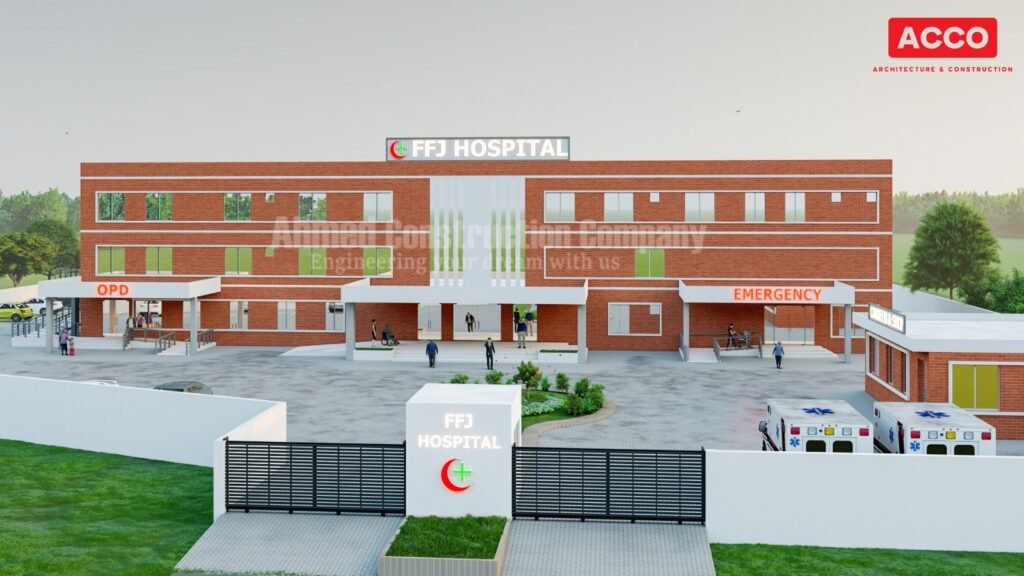ACCO provides expert guidance on 100 bed hospital construction feasibility in Pakistan—covering land, cost, planning, and healthcare design standards.



100-Bed Hospital Construction Feasibility in Pakistan | Cost & Planning Guide
Meta Title: 100-Bed Hospital Construction Feasibility in Pakistan | ACCO Healthcare Experts
Meta Description: Discover the cost, planning, and key factors for building a 100-bed hospital in Pakistan. Expert feasibility and construction services by ACCO Healthcare Solutions.
🏥 100-Bed Hospital Construction Feasibility in Pakistan
Building a 100-bed hospital in Pakistan requires careful feasibility studies, cost planning, and expert design to meet healthcare standards. ACCO Healthcare Solutions specializes in providing turnkey hospital construction services, from conceptual planning to complete execution.
📈 Key Factors in Hospital Feasibility
-
Land Requirements:
A 100-bed hospital typically requires 30,000 to 50,000 square feet of land, depending on the design and expansion possibilities. -
Design and Layout Planning:
Efficient zoning of emergency, ICU, OPD, inpatient wards, diagnostic centers, and administrative areas is critical for functionality. -
Construction Cost Estimates:
-
Grey Structure: PKR 6,000 to 7,000 per square foot
-
Finishing Works: PKR 8,000 to 10,000 per square foot
(These are estimates. Costs can vary based on location, design complexity, and material quality.)
-
-
MEP Services (Mechanical, Electrical, Plumbing):
Specialized MEP systems are essential for hospital operations, adding 20–30% to the total construction cost. -
Equipment and Furnishing:
Medical equipment procurement must be integrated with the design phase to ensure proper space allocation and infrastructure compatibility.
🏗️ Construction Phases for a 100-Bed Hospital
-
Feasibility Study and Site Analysis
-
Architectural and Engineering Design
-
Municipal and Healthcare Regulatory Approvals
-
Grey Structure Construction
-
Interior Finishing and MEP Installations
-
Medical Equipment and Furnishing Setup
-
Testing, Commissioning, and Handover
✅ Explore more about Hospital Design Services in Pakistan by ACCO.
💰 Estimated Construction Budget
| Construction Element | Estimated Cost (PKR) |
|---|---|
| Land Acquisition (Optional) | Varies (City/Location) |
| Grey Structure (50,000 sqft) | 300M – 350M |
| Finishing Works | 400M – 500M |
| Medical Equipment Setup | 200M – 300M |
| Total Estimated Budget | 900M – 1.2 Billion |
Note: Prices are approximate as of 2025 and subject to market fluctuations.
🌟 Why Choose ACCO for Hospital Construction?
-
20+ Years of Healthcare Design & Construction Experience
-
In-House Architects, Engineers, and Medical Planners
-
Turnkey Project Delivery: From Concept to Completion
-
Compliance with Healthcare Regulatory Standards
-
Smart Designs Focused on Efficiency and Patient Comfort
🔗 Learn more about our Hospital Construction Services and how ACCO can support your project from start to finish.
📞 Ready to Start Your 100-Bed Hospital Project?
Contact ACCO Healthcare Solutions today to discuss customized hospital planning and construction services tailored to your needs.
Phone: +92 322 8000190
Email: info@acco.com.pk
Website: www.acco.com.pk

